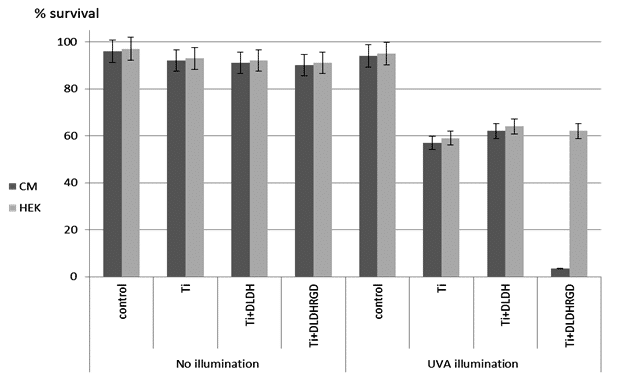
RGD DERIVATIZED DIHYDROLIPOAMIDE DEHYDROGENASE COMPLEXED WITH TiO2 NANOPARTICLES AS A PHOTODYNAMIC CYTOYOXIC AGENET IN CUTANEOUS MELANOMA
2Department of Human Molecular Genetics and Biochemistry, Sackler School of Medicine, Tel Aviv University, Tel Aviv
Cutaneous Melanoma (CM) is the most aggressive and fatal form of skin cancer worldwide. CM cancer cells overexpress on the cell surface receptor integrin (e.g avb3), which interacts with proteins of the Extra Cellular Matrix (ECM) through an RGD (arginine-glycine-aspartic) binding site.
Photodynamic therapy (PDT) is a promising antitumor treatment that combines non-toxic illumination with photoactivatable photosensitizer. The cytotoxic effect of photo-excited titanium dioxide (TiO2) by UV illumination, generating Reactive Oxygen Species (ROS), has been examined in several cancer models. However, serious damage to the surrounding healthy tissue limits the applicability of this approach.
Investigations carried out by our group have shown that Dihydrolipoamide Dehyrogenase (DLDH), strongly binds to TiO2 via stable non-electrostatics, coordinative bonds. In order to combine the cytotoxic effects of TiO2 and DLDH with the targeting effect of RGD we have bio-engineered a hybrid nanobiocomplex of TiO2-DLDH-RGD2 which possesses RGD moieties on the N- and C-termini of the protein, thus generating a protein capable of serving as a bridge between the integrin expressing cancer cells and TiO2 nanostructure forms.
As shown in Fig. 1 illumination for 1hr with UVA activates the TiO2 and induces cell death in both cancer (B16F10) and normal (HEK293) cells. In CM this effect is enhanced upon TiO2-DLDH-RGD2 addition (in B16F10 only). No such effect was observed without UVA illumination.
We believe that the understanding gained from this work will also be beneficial to other integrin-expressing tumor models that have not been tested so far.

Fig. 1 – % survival of cells (HEK293 - normal, B16F10 - CM) with/without UVA illumination (1h 365nm) after 48h incubation
Powered by Eventact EMS